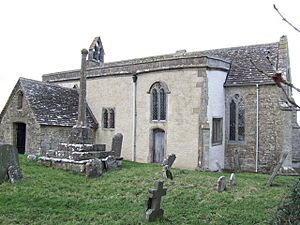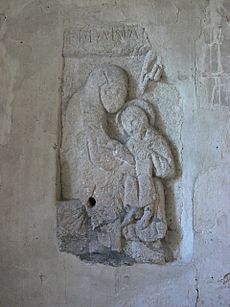St John the Baptist Church, Inglesham facts for kids
Quick facts for kids St John the Baptist Church, Inglesham |
|
|---|---|

St John the Baptist Church, Inglesham, from the south-east
|
|
| Lua error in Module:Location_map at line 420: attempt to index field 'wikibase' (a nil value). | |
| OS grid reference | SU 20532 98431 |
| Location | Inglesham, Borough of Swindon, Wiltshire |
| Country | England |
| Denomination | Church of England |
| Website | Churches Conservation Trust |
| History | |
| Dedication | Saint John the Baptist |
| Architecture | |
| Functional status | Redundant |
| Heritage designation | Grade I |
| Designated | 26 January 1955 |
| Architectural type | Church |
| Style | Anglo-Saxon, Gothic |
| Specifications | |
| Materials | Rendered rubble stone, Stone roofs |
| Administration | |
| Parish | Highworth with Sevenhampton and Inglesham |
| Deanery | Swindon |
| Archdeaconry | Malmesbury |
| Diocese | Bristol |
| Province | Canterbury |
St John the Baptist Church in Inglesham, near Swindon, Wiltshire, England, is a very old church. It has parts that date back to the Anglo-Saxon period. Most of the church you see today was built around the year 1205. It's amazing because much of the church has stayed the same since the medieval times!
This church is considered a very important historical building. It's listed as a Grade I building on the National Heritage List for England. This means it's one of the most important historic buildings in the country. Since 1981, the church has been looked after by the Churches Conservation Trust. This group helps to protect old churches that are no longer used for regular services.
The church is located in a beautiful spot. It stands near water meadows where the River Thames, River Coln, and the Thames and Severn Canal meet. Inside, you can find amazing wall paintings. Some of these paintings are over 600 years old! They were often painted one on top of another, with some spots having up to seven layers of paint. There's also a special carving of the Mother and Child from the Anglo-Saxon era. The church also has old box pews, a pulpit, and memorials.
Contents
History of the Church
Early Beginnings
In 1205, King John gave the church to a group of monks called the Cistercians. These monks lived at Beaulieu Abbey. Later, in 1231, Pope Gregory IX gave permission for the church at Inglesham to officially belong to Beaulieu Abbey. This happened because King Henry III asked for it.
In 1355, the Inglesham manor (the land and buildings) and the church were given to a hospital in Leicester. This hospital was called the College of the Annunciation of St. Mary.
Saving the Church in the 1800s
In the 1880s, there were plans to make big changes to the church. This was part of a trend called Victorian restoration, where old buildings were often heavily changed. However, a famous artist and writer named William Morris stepped in. He lived nearby and was worried that the changes would ruin the church's historic look.
William Morris was a key figure in the Arts and Crafts Movement. He started a campaign to save the church from these changes. His efforts led to support and even fundraising from the Society for the Protection of Ancient Buildings (SPAB). Morris helped create the SPAB in 1877. Its main goal was to protect old buildings by fixing them carefully, without changing their original design.
The SPAB hired J. T. Micklethwaite to manage the repair work in 1888 and 1889. Another person, Oswald Birchall, surveyed the church. This helped Morris and John Henry Middleton write a report for SPAB in 1885. They suggested that the repairs should be paid for by the SPAB because the local church leader, George Woodbury Spooner, said the villagers couldn't afford it.
Later Repairs and Current Status
More repair work was done in 1933 by Percival Hartland Thomas. He helped replace parts of the reredos (a screen behind the altar) from around 1330.
The church stopped being used for regular services in April 1980. It was then officially given to the Redundant Churches Fund in October 1981. This fund is now known as the Churches Conservation Trust, which continues to care for the church today.
Church Architecture
Outside the Church
This small church doesn't have a tall tower. Instead, it has a special double bellcote on the west side of the nave (the main part of the church). This bellcote was built in the 13th century and holds two bells. These bells were made in 1717 by Abraham Rudhall, a famous bell maker.
The church walls are covered in a white coating called limewash. They are about 26 inches thick and 21 feet high. The church has a nave that is 25 feet long and 13 feet wide. It also has a chancel (the area around the altar) that is 21 feet long and 12 feet wide. The roof of the chancel might even date back to the 13th century. The nave roof has old medieval wooden supports.
Outside the church, there is a stone cross from the 15th century. It has three steps leading up to a tall stone shaft. This cross is also a listed building, showing its historical importance.
Inside the Church
The inside of St John's Church is like a time capsule! It has amazing wall paintings that were created between the 13th century and the early 1800s. Some of these paintings are shown in a book by Professor E. W. Tristram. He noted that pieces of a reredos (a decorated screen behind the altar) with paintings of four saints still exist.
Some of the wall paintings are on crumbling plaster, hidden behind texts painted after the English Reformation. In some places, there are up to seven layers of paint, showing how the church's look changed over hundreds of years. You can see 15th-century angels above the chancel arch (the archway leading to the altar area). There's also a "Doom painting" from the early 1300s on the east wall of the north aisle. This type of painting showed scenes of heaven and hell.
Later, during the Victorian era, texts like the Ten Commandments, the Apostles' Creed, and the Lord's Prayer were painted on the walls. In 2010, special work was done to restore these paintings, which meant the church had to be closed for a while.
One of the most special items is a carving of the Mother and Child. This carving is 42 inches by 24 inches and dates back to the Anglo-Saxons. For a long time, until 1910, this carving was on the outside of the church. It was even used as a sundial! Lines and a hole were added to it so people could tell the time from the sun. We don't know where it was originally placed inside the church, but it might have been above the altar.
The church also has parclose screens, which are wooden screens that separate areas. There are also Carolean-style box pews from the time of the Commonwealth era. The font, used for baptisms, is from the 15th century. The Jacobean pulpit (where sermons are given) and its tester (a canopy above the pulpit) are from around 1630.
On the floor of the chancel, there is a large black marble slab that is 10 feet long. This slab once held a monumental brass of a knight from the 1300s. The brass would have shown the knight wearing a helmet, holding a sword, and having four shields.
Parish Connections
In 1940, the Inglesham church and its parish (the area it serves) joined with Highworth, which is about 4 miles away. The Highworth parish is still responsible for taking care of the churchyard at Inglesham.
Why St John's is Special
St John's Church was a particular favorite of John Betjeman. He was a famous poet, writer, and broadcaster who also helped start the Victorian Society.
Richard Taylor, who presented a TV show called Churches: How To Read Them, said Inglesham was his favorite church out of hundreds he visited. He described it as a "totally unassuming building" that, despite its simple look, told the story of over 1,000 years of religious history inside. He mentioned the Anglo-Saxon carvings, medieval wall paintings, and Bible passages from the Reformation era. The TV show also highlighted how William Morris and the Society for the Protection of Ancient Buildings fought to protect the church from changes in the 1880s.
Gallery
See also







